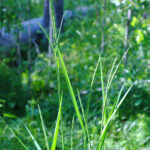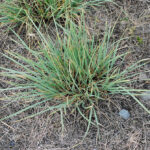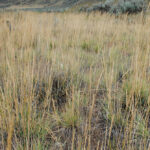Seigle sauvage bleu
Elymus glaucus
General Description
Blue wildrye, also known as smooth wildrye, is a bluish-green, tall, tufted, native cool season perennial grass. The root system is fibrous and may have short rhizomes. The plant forms small tufts of a few stems between 50 to 150 cm (20 to 59 in) tall. The stems have a waxy covering that contribute to the plant’s bluish-green colour and name.
Type
Native grass.
Origin
Blue wildrye is native to North America.
Longevity
Blue wildrye is considered short lived (i.e., 3-8 years).
Use
Native revegetation of disturbed or burned areas, erosion control for steep slopes. Wildlife habitat for mammals and birds
Optimal Time of Use
Summer and fall.
Recovery After Use
Does not tolerate heavy grazing. Close grazing in spring eliminates a stand of blue wildrye within 3 to 5 years.
Palatability/Nutritional Value
Most palatable to wildlife and livestock in the early part of the season. Forage value declines with maturity. This grass is not readily eaten after the seed heads are formed.
Annual Precipitation min/max (mm)
400mm / 1500mm
Drought Tolerance
Varies with ecotype. Some are adapted to dry grassland sites.
Flooding Tolerance
Low flooding tolerance but will tolerate somewhat poorly drained soils (i.e., saturated less than one week in the spring).
Winter Hardiness
Variable with ecotype.
Soil Texture Preference
No preference.
Erosion Control
A pioneer species with hardy fibrous root system has some value in erosion control especially on steep sites with coarse soils.
Salinity Tolerance
Low tolerance.
Acidity Tolerance
Low to moderate tolerance. Will tolerate pH down to 5.8.
Alkalinity Tolerance
Low to moderate tolerance. Will tolerate pH up to 8.5.
Seeds per kg
219,000 seeds/kg (99,337 seeds/lb)
Suggested Mixtures
Should be included in a mixture for revegetation seedings.
Ease of Establishment
Can be easy to establish.
Competitiveness
Considered highly competitive as it has high seedling vigour, establishes rapidly, and has good ground protection. It is also a good seed producer and reseeds readily.
Management Considerations
Cultivars and selected varieties have been developed. The genetic source should be identified before application. There is wide variation in this species and outcrossing with local populations is possible.
BC Rangeland Seeding Manual, USDA Plants Database
Blue wildrye is common in transitional areas in the Sub-Boreal Spruce, Sub-Boreal Pine–Spruce, and Interior Douglas-fir zones.
Blue wildrye is most suited for dryland range, pasture or reclamation where native species are desired in transitional areas in the Ponderosa Pine and the Interior Douglas-fir zones and in the Interior Cedar-Hemlock zones. An awnless type was successfully established in a trial in the semi-arid part of the Bunchgrass zone near Kamloops.
Blue wildrye is found in the native plant communities of the Peace-Liard region (Boreal White and Black Spruce zone) but it is less common than in the Central Interior BC zones.



